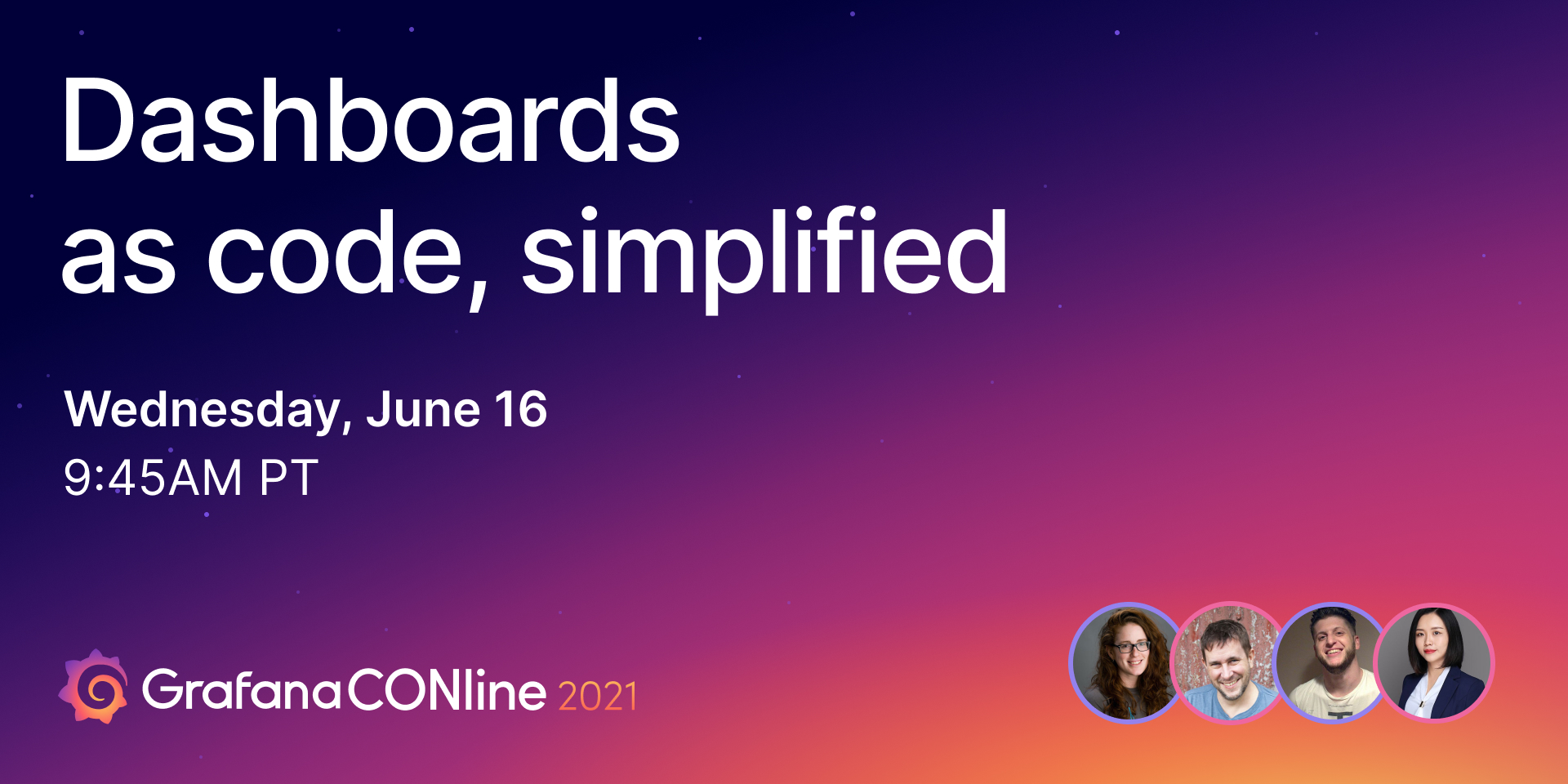
GrafanaCONline 2021 Day 5 recap: Grafana alerting, dashboards as code, synthetic monitoring in Grafana Cloud, and more!
GrafanaCONline 2021 is still going strong and you can tune in live (for free!) or sign up to get notified about on-demand access to all the session recordings, which will be available after GrafanaCONline ends.
Here’s what you missed on Day 5 of the conference:
What’s next for alerting in Grafana
One of the biggest features introduced in Grafana 8.0 is a unified alerting system, which means that whether you’re using Grafana OSS, Grafana Cloud, or Grafana Enterprise, there will be an identical alerting system that behaves exactly the same from product to product. In this session, the Grafana team showcased the new alerting system in a comprehensive demo and also walked through the massive transformation that took place on the backend to unify all the APIs and introduce a fully integrated Prometheus Alertmanager. Then the team gave a sneak peek of the future of alerting in Grafana, which includes multi-dimensional alerting, the ability to mix data sources, and improvements in workflows to make alerts more informative and intuitive.

The session will be available on demand here.
Dashboards as code, simplified
Grafana Labs Engineering Manager Jessica Brown, Senior Software Engineer Malcolm Holmes, Principal Engineer Sam Boyer, and Software Engineer Ying Wang teamed up to introduce the latest developments that simplify “as code” working styles. First, they showed a new schema for Grafana dashboards that removes the reverse engineering that had been previously required. Then the Grafanistas shared improvements to existing tools and techniques such as a new approach to packaging observability resources, making it easy to install and upgrade dashboards and alerts as a single unit. There’s also new tooling that allows you to store your dashboards in GitHub while enjoying the versatility of the Grafana UI, thus making Grafana, Prometheus, and other tools first-class citizens in your DevOps automation workflows.

The session will be available on demand here.
How to set up and visualize synthetic monitoring at scale with Grafana Cloud
Grofers Software Development Engineer (and longtime user of Grafana Labs technology) Yashvardhan Kukreja stepped in to explain how synthetic monitoring helps you understand your users’ experience and improve website performance by proactively monitoring your services.
He then provided an overview of how to use Kubernetes, Grafana Loki, and Grafana Cloud’s synthetic monitoring feature to set up your infrastructure’s checks that can span multiple countries and continents. The session also included a hands-on demo to set up a synthetic monitoring plugin in Grafana from scratch in less than five minutes.

The session will be available on demand here.
Using Grafana to inform the public of COVID’s economic impact in near-real time
When COVID-19 hit, Dénes Csala, Visiting Assistant Professor in Data Visualization at Babes-Bolyai University of Cluj-Napoca in Romania, set out to create a comprehensive information dashboard that could track the longer economic effects of the unpredictable and unprecedented pandemic in Romania. In this talk, Dénes, who is also an Assistant Professor and Lancaster University, broke down why Grafana was the best tool for the COVID-19 Romanian Economic Impact Monitor, one of the main sources of public information about the pandemic in Romania for more than a year. The site correlates government actions with the evolution of the pandemic and tracks relevant economic health indicators in near-real time, such as mobility around the country and changes in the real estate market. Dénes walked through the Impact Monitor’s Grafana frontend, which is heavily customized (the site operates in three languages — Romanian, Hungarian, and English — and offers dark and light themes) and leverages built-in Grafana plugins (check out the GrafanaCONline plugins showcase on demand), community plugins, and several custom visualizations. All the services are integrated into Docker containers, and all of the source code is forkable on GitHub.

The session will be available on demand here.
Grafana onboard the SOFIA airborne astronomical observatory
The SOFIA airborne astronomical observatory is a NASA and German Aerospace Center endeavor consisting of an extensively modified Boeing 747SP aircraft carrying a 2.7-meter reflecting telescope. Ronan Higgins, an astronomer at University of Cologne, launched his session with a look at how a Grafana deployment onboard the SOFIA observatory streamlines the display of about 2GB of data that’s collected during each flight as well as monitors multiple subsystems (aircraft, telescope, astronomical instrument, astronomical data, computer network) in one unified place. The talk included how astronomers on SOFIA use Grafana, which is deployed as part of the upGREAT instrument software stack, to create dashboards for flight data, data quality monitoring, and subsystem monitoring. These dashboards then allow for quick comparisons of the data stream and help correlate data quality issues while in flight. Finally Ronan discussed what’s written in the stars for Grafana and SOFIA, such as plans to leverage alerting for in-flight issues with data quality and develop an interactive reduction pipeline to make changes on the flight based on the time series data from Grafana.

The session will be available on demand here.
Building a 360-degree observability platform with the Grafana Stack
Boris Gdalevich, Head of Observability and Event Management at the global investment company KKR, provided an in-depth overview of how his team developed the company’s observability infrastructure. His comprehensive demo includes how his team incorporated Grafana Enterprise, Grafana Enterprise Logs, and Grafana Enterprise Metrics to support a 360-degree observability ecosystem, including monitoring and event notification for various infrastructure and application services.

The session will be available on demand here.
Today’s sessions
Get more and spend less with Grafana Loki for logs at 9:00 PT, 12:00 ET, 16:00 UTC with Jen Villa, Cyril Tovena, Danny Kopping, and Levente Balogh from Grafana Labs
Using Grafana to visualize Continuous Delivery Indicators in the open source Jenkins X cloud native CI/CD project at 9:45 PT, 12:45 ET, 16:45 UTC with Dailymotion Principal Engineer Vincent Behar
Enhancing observability for High Performance Computing Infrastructure with Grafana at 10:10 PT, 13:10 ET, 17:10 UTC National Center for Supercomputing Applications HPC Storage Engineer J.D. Maloney
Using the Grafana Stack to visualize and manage overall service health and alerts at 10:35 PT, 13:35 ET, 17:35 UTC with Salesforce Software Engineering Manager Joe Pallotta
The business of Grafana Labs at 11:20 PT, 14:20 ET, 18:20 UTC with Grafana Labs CEO and Co-founder Raj Dutt
Check out the full GrafanaCONline 2021 schedule here.
And don’t forget you can connect with the Grafana community and get the latest updates from the Grafana Labs team during the event on Slack. Sign up here and join the #grafanaconline channel.



